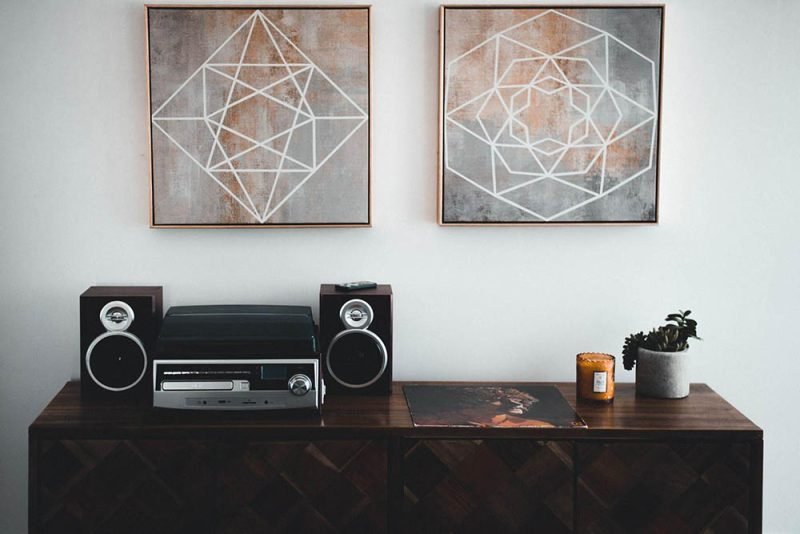
You might be asking, “Why can’t I use regular speakers for my home studio?”
Do I have to buy another kind of speaker called studio monitors?
I’ll be covering the differences between the two. Click this link if you want more info about studio monitors, like how to connect studio monitors.
Sound Profile
Let’s start with the biggest and main difference between speakers and monitors. The biggest one is the sound profile.
Regular speakers have the goal of making the listening experience an enjoyable one. This is what causes them to give what is known as a “colored response.”
Colored response means that there are certain tweaks in the frequency that make the played audio sound more appealing. An example of a tweak would be an increase in the lower frequencies, which are found in bass-boosted speakers.
As for studio monitors, they have the opposite of a colored response, a flat response.
There are no tweaks, cuts, or boosts when playing audio. So what you hear is what you get. This is very important for audio production because it requires proper mixing and mastering.
A flat response will help you know which part of the mix is okay and what needs fixing. Having a cut or boost in the speakers can influence your decisions when mixing and mastering, which could lead to a not-so-good mix popping up.
So in this case, both speakers have different sound profiles since they are intended for different purposes. One is for recreational/commercial use, while the other is for audio production.
Projection
The projection of speakers and monitors are widely different from one another. As such, the environment for both projections differs.
Speakers benefit greatly in a living room, or any space likened to one. Other areas include dining rooms, dens, and outdoor settings.
As for monitors, they are used greatly in more enclosed spaces like your bedroom. Smaller, more enclosed areas make it less likely for the room to alter the frequencies, whether it increases or decreases. That way, the sound’s true frequencies are retained.
The difference in projection is based on the different purposes these speakers have.

Active and Passive
Active speakers and passive speakers differ in how they need to be powered.
While studio monitors can be both active and passive, most monitors are active. Active speakers come with built-in amps and drivers, so they don’t require external amplification. This makes for more clarity and wider frequency range during playback.
On the other hand, passive speakers require external amplification and need to be plugged in. This will be fine for commercial use but not so much for audio work. You could miss out on some details and frequencies, especially if you have to rely on external power sources.
Pros and Cons of Speakers
Speakers, especially those of good quality, make for a great listening experience. If you want to play music in your living room or want the atmosphere of a party or gathering to be fun and vibrant, these will be good choices.
These are also recommended if you want to create a home theater.
However, this will cost you the true sound of whatever song you are playing. And you don’t want this to happen if you are producing music.
Pros and Cons of Studio Monitors
If high quality is what you will gain from speakers, then a sound’s true quality is what you will gain from studio monitors.
From a flat frequency response to a high dynamic range, these will help you create some great-sounding tracks.
If there was a drawback, it would be accessibility. Since it is geared toward music producers, their access could be narrower than commercial speakers.
But they are still present, and some sell for an affordable price.
So, which is better?
Now when it comes down to asking this question, the correct answer is there is no better option.
Both forms of speakers are great in their own way. All that should matter is the quality of the product you decide to purchase.
The main thing you should ask is what you plan to use them for. If you just want to add music to your living room or den, then get high-quality loudspeakers.
But, if you are an audio engineer or looking into producing your own music, studio monitors are where it’s at.
They have different uses and excel in those uses.
Frequently Asked Questions
Can I use monitors for casual listening?
Well, you technically can. They function similarly to speakers apart from the differences mentioned.
That said, you won’t get those special boosts you typically find in speakers. Whether that’s a good thing for casual listening is up to you.
Getting powered speakers is preferred when it comes to casual listening compared to studio monitors.
Nearfield or far-field studio monitors?
There are two kinds of studio monitors that you will come across.These are nearfield and far-field studio monitors.
The choice will depend on your setup. Even if studio monitors are used in enclosed areas, not every home studio is sized similarly.
At the same time, professional recording studios will look a bit bigger than your bedroom. Not to mention, they are built differently.
So choosing the right monitor will depend on the specs of where you make music.
So is there no use for regular speakers in music production?
Don’t fret because there actually is.
While not found during the mixing and mastering steps themselves, you can use them for another important part of the process.
If you are working on a master, you can try playing them on different speakers to see how they sound. At the end of the day, the goal is not only to get great quality music tracks but also to have them be consistently good in any speaker.
One of the reasons why playing your track on a car is a good way of verifying if it is good.
Since most people will be playing music on speakers, you can see how the track plays out in a speaker to see if it is good to go or still needs work.
Conclusion
At the end of the day, it all depends on what you want to do. If you figure that out, choosing which one will benefit you will be much easier.
Hopefully, this article helped you figure out the difference between the two.









